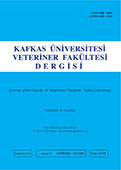
This journal is licensed under a Creative Commons Attribution-NonCommercial 4.0 International License
Kafkas Üniversitesi Veteriner Fakültesi Dergisi
2018 , Vol 24 , Issue 5
The Influence of Carcass Microlocation on the Speed of Postmortem Changes and Carcass Decomposition
1Faculty of Agriculture, Department of Veterinary Medicine, University of Novi Sad, Trg Dositeja Obradovića 8, 21000 Novi Sad, SERBIA2Faculty of Veterinary Medicine, University of Belgrade, Bulevar Oslobođenja 18, 11000 Belgrade, SERBIA DOI : 10.9775/kvfd.2018.19670 Determining the post mortem interval (PMI) is often a very demanding and delicate job which requires a good knowledge of postmortem changes. In this study, 20 domestic pig carcasses (Sus scrofa) whose death occurred within 8 h before the start of the study were simultaneously laid at the same geographical location, but in different environments (on the ground surface - S; buried in the ground - G; placed in a crate and buried in the ground - C; submerged in water - W; and hanging in the air - A). One carcass from each group was sampled on days 14, 28, 120 and 190 from the beginning of the experiment, and on that occasion, a detailed analysis of postmortem changes and an autopsy was carried out. The difference in the rate of decomposition among groups was statistically significant. The fastest decomposition occurred in carcasses placed in a crate and buried, because during the winter period the temperature in the air was below 0°C. At that time, the decomposition process and the insect activity were slowed or stopped on carcasses in groups S, A, W, and G to some extent, while the ground and wooden crate were good thermal insulators for group C carcasses and provided better conditions for insect activity. Keywords : Forensic veterinary medicine, Postmortem changes, Decomposition, Taphonomy, Pig carcass










